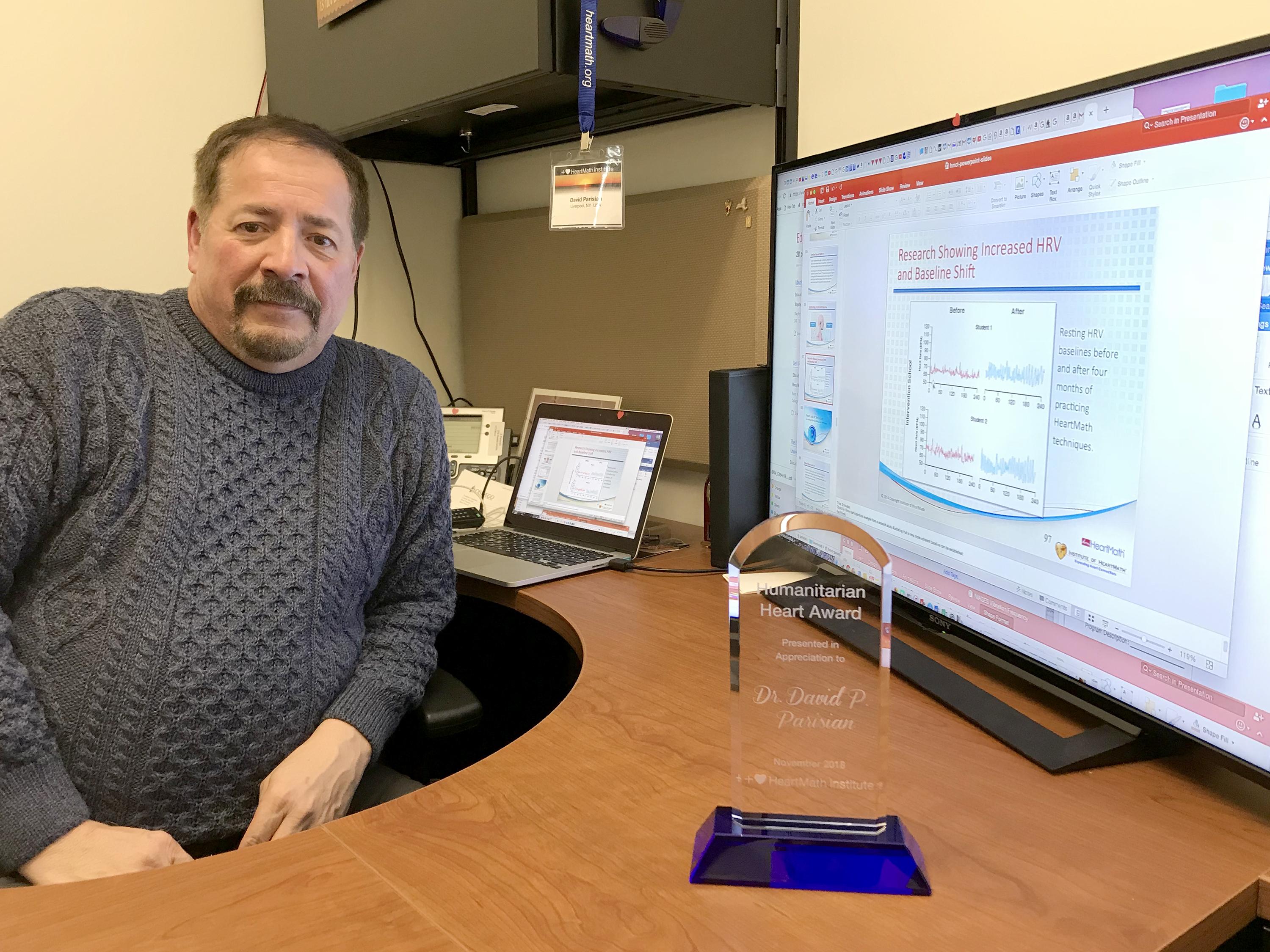Humanitarian award -- David Parisian of SUNY Oswego’s curriculum and instruction faculty recently earned the 2018 Humanitarian Heart Award from the HeartMath Institution, recognizing his contributions to the field of psychological/physiological research.
David Parisian of SUNY Oswego’s curriculum and instruction department recently received the 2018 Humanitarian Heart Award from the HeartMath Institute.
A visiting assistant professor in the School of Education after 30 years as a public school science teacher and administrator, Parisian was one of three individuals recognized by the organization, which conducts research on heart-brain communication and its relationship to managing stress. The awards recognize “energetic care and work toward the healing, enrichment and well-being of others,” the HeartMath Institute said.
Parisian has taught and trained others, particularly in the HeartMath breathing technique, which focuses on regularly breathing deeply for a short period to reset the body’s state. Using HeartMath’s technology, individuals get feedback on their Heart Rate Variability (HRV). They watch their heart rhythms change as they shift their emotions.
“We know the heart is more than a pump. The heart is an intelligent information processor that sends more information to the brain than the brain sends to the heart. We have to change our view and perception of the heart,” Parisian said.
“I’ve been teaching this technique using their HRV sensors, which teaches you how to reconnect your heart and mind,” Parisian explained. “It’s a great way to reset yourself when you feel anxiety or stress. It’s an awesome tool.”
The institute explains that its research demonstrates “that different patterns of heart rhythms … have distinct effects on cognitive and emotional function.” It recommends a 3x6x5 approach: doing the breathing exercise three times a day, with six deep breaths per minute for five minutes.
As a person breathes slowly, evenly, the individual brings in a regenerative emotion such as appreciation, gratitude or care and re-experiences that feeling. This technique brings the heart into what is known as the state of coherence.
“When you’re stressed, your stress response sends you into fight, fly or freeze mode,” Parisian said. “You can’t think clearly when you’re stressed.”
This is intended to get people out of that mindset quickly so they can return to a productive state. “In any situation, people have a choice on what kind of reaction they want to have,” Parisian said, “so this is a very helpful tool and technique in today’s world.”
The technique translates into a practical drive of optimal performance (for athletes or everyday cognition), intelligent energy management and emotional self-regulation, Parisian said.
“I like that this technique is available on demand,” he said. “It doesn’t require anything special. Besides, you have to breathe anyway -- make a few more breaths slower and deeper.”
Parisian praised the other two recipients of this year’s award -- Ann Baldwin, founder of Mind-Body-Science and a member of the University of Arizona faculty, and Steve Sawyer, cofounder of the New Vision Wilderness nonprofit. “It’s great company to be in,” Parisian said.
Helping students
Linda Rae Markert, the former dean of Oswego’s School of Education, invited Parisian several years ago to introduce the training into the curriculum of Project BLEND (Building Leadership Excellence for Needs-based Districts) for school administrators. The program, sponsored by the state’s Education Department, supported aspiring leaders looking to expand their roles in school districts and buildings, particularly in high-need schools.
The training has made its way to high-stress professions, such as the military, healthcare and law enforcement, where being able to control emotions and stress can literally be a matter of life and death, Parisian said.
He recalls teaching an introductory college computer science class where students said it made a lasting impact on them, and was the first time they heard about how their emotional states could impact their physical state.
The responses in evaluations confirm the exercise’s value, with students noting it “helped me learn how to deal with and recognize the stress I have,” “allowed me to appreciate myself more and positive aspects of my life” and “helped me stay cool in stressful situations.”
“There have been many times where I struggle with anxiety from tests and many times in my life where stress just seems to take over,” another student wrote. “HeartMath has allowed me to regain my life and focus on myself. … I find the value in connecting my mind and my heart in order to be in a more productive state.”
Another student who reported the anxiety had started making them sick “found that breathing slowly and rhythmically helped me come back to reality and stop feeling so anxious.” One student said: “The biggest thing for me was being able to take 5 minutes for myself to focus on me and my breathing to try and destress.”
Learning this kind of self-regulation technique and passing it along to students dovetails with new teaching guidelines that place a great emphasis on social-emotional learning, Parisian said.
HeartMath products, tools, techniques and technology are based on more than 25 years of scientific research conducted at the HeartMath Institute on the psychophysiology of stress, emotions and the interactions between the heart and brain, with more than 300 research articles, with many being peer-reviewed or independent studies utilizing HeartMath techniques or technologies, in publication, according to the organization’s website.




